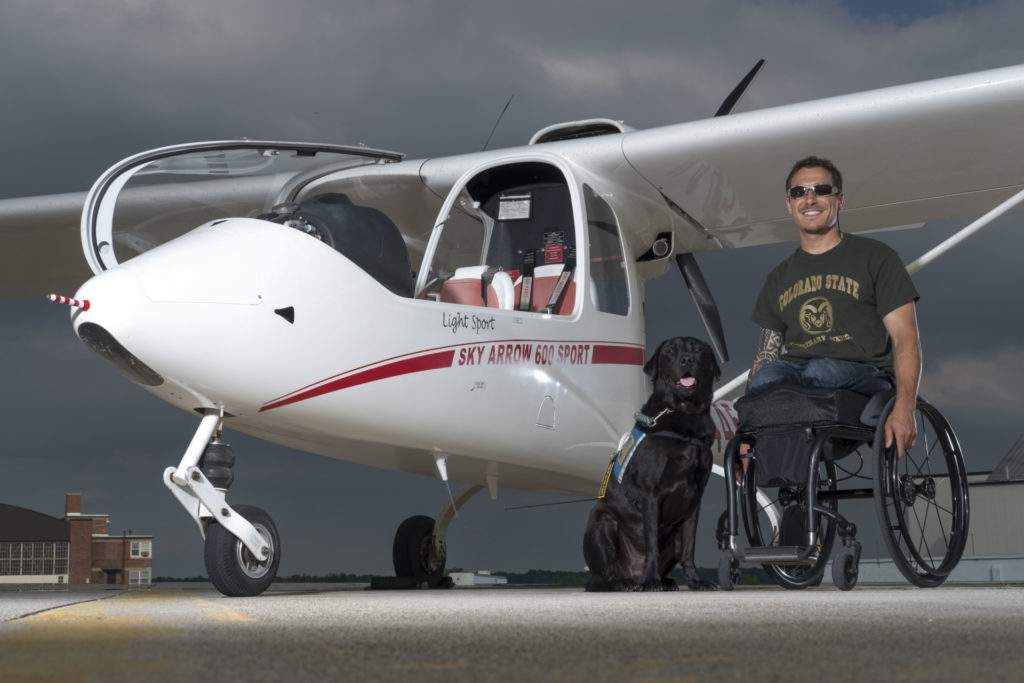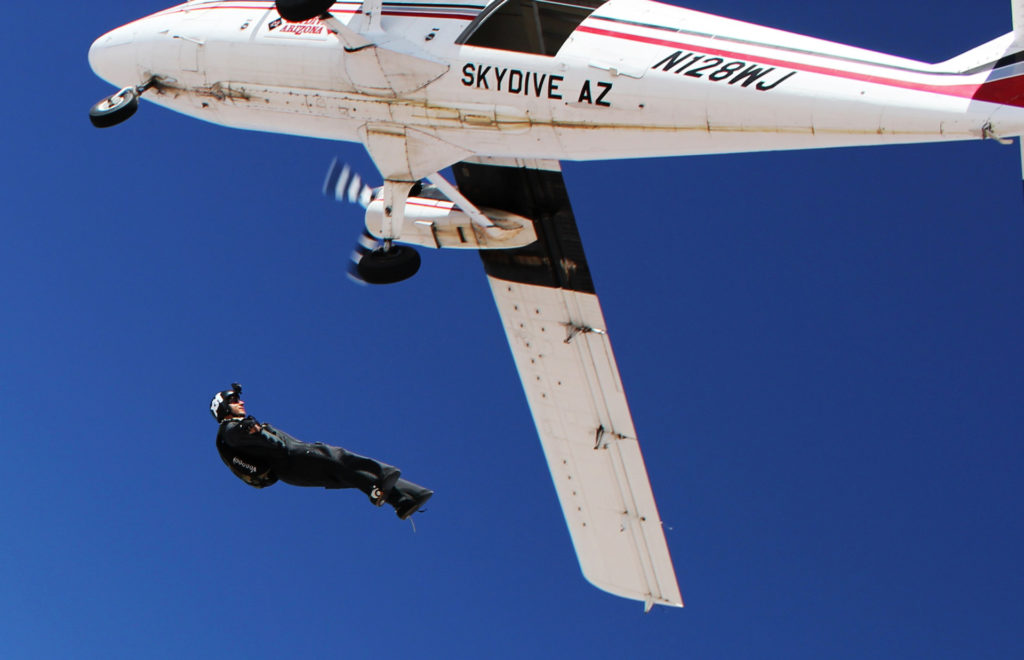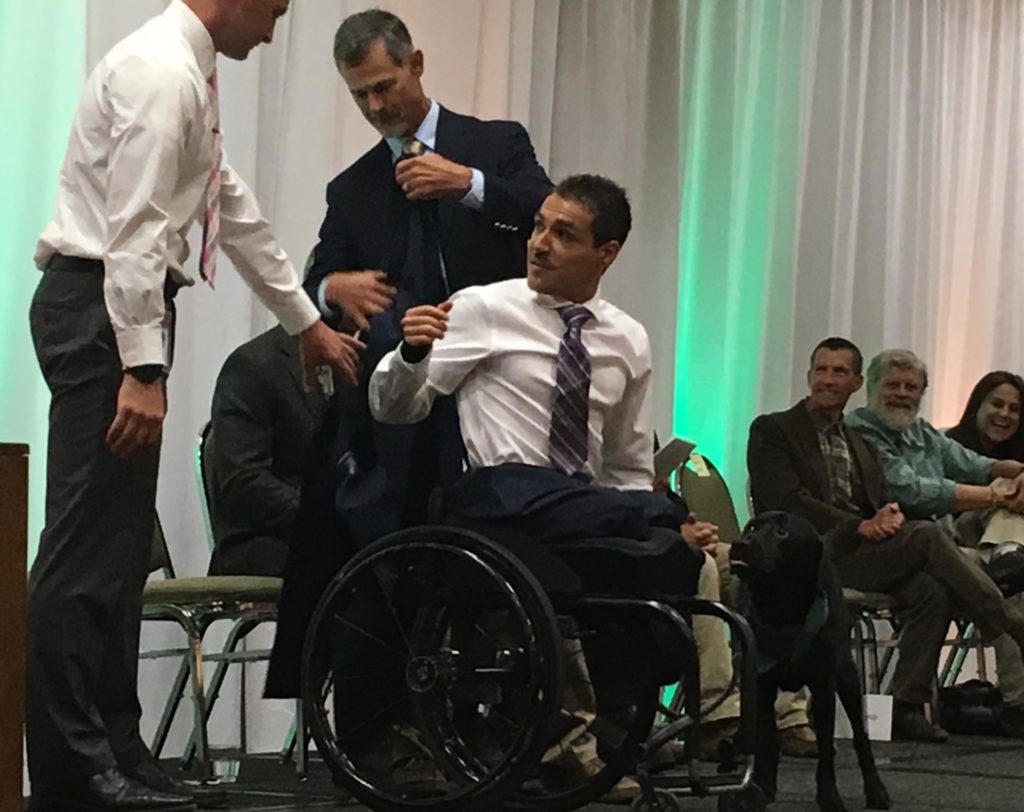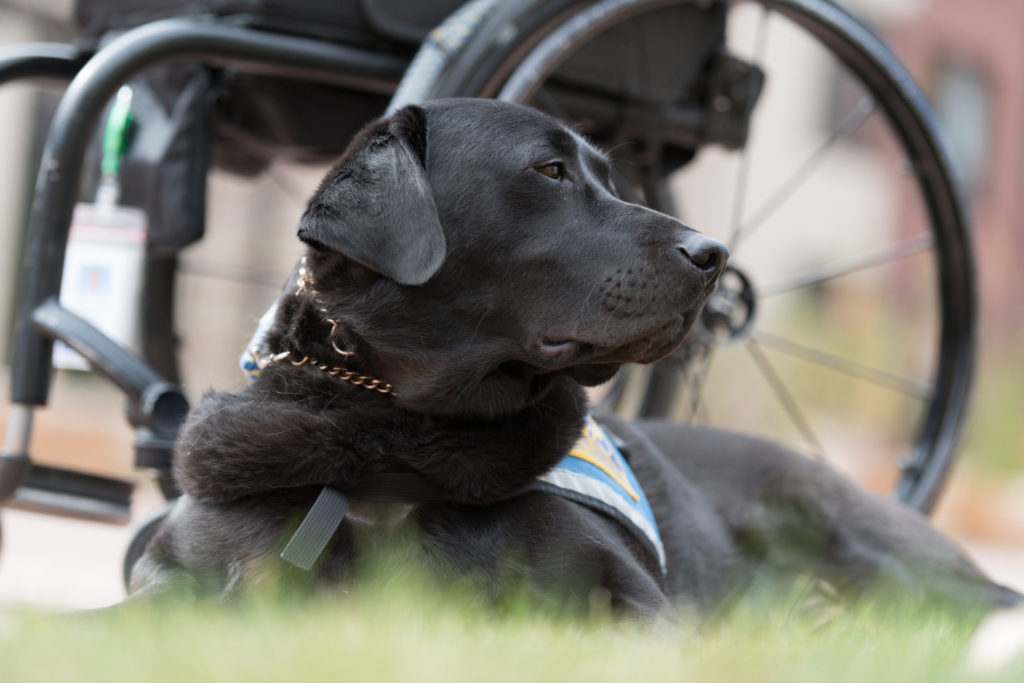The sky’s the limit for CSU’s first paraplegic veterinary student
by Kristen Browning-Blas | November 18, 2016 11:21 AM
Until the day he crashed into the Arizona desert going 90 miles an hour, the sky was the limit for Bernard Dime. He was an accomplished skydiver ready to enlist in the U.S. Army, and set on making the elite Golden Knights Parachute Team.
But the driven 25-year-old’s ambitious plans changed dramatically on one last practice jump before a competition, when something went wrong and he hit the ground, shattering his back.
 [1]
[1]“I don’t remember the impact. I don’t remember the pain all that much, just brief moments laying on the ground and thinking I was going to die,” said Dime, now 29.
Four years after his accident, Dime has undergone the agonizing work of recovery and reassessing his life plans, a path inspired in part by his devoted service dog, Corky. He is at the doorway of a career in veterinary medicine – the first paraplegic veterinary student to enter the Doctor of Veterinary Medicine Program at Colorado State University.
Refocusing his dreams began painfully, when Dime was airlifted to a hospital and learned he had burst-fractured the T12 and L1 vertebrae in his lower back and had suffered a spinal cord injury. He was permanently paralyzed and underwent surgical amputation of his legs.
“You crash, and then you wake up born again with a different body,” Dime said.
But at the time, he didn’t feel born again. He felt like the life he had planned was over. During the following months of rehab, his energy went into learning how to shower, how to dress himself, how to live with his new body.
“There were times I wished I was dead. I thought, ‘My life is never going to be good again.’ That’s rock-bottom. That’s a scary place,” he said.
The young man who had counted on his physical fitness to carry him into a career as an elite skydiver had to come to terms with the abrupt end of that dream. Lying in the hospital, he pondered his childhood dreams of being a musician (In his late teens, he was a guitarist in a touring band called The Real You[2] whose music was featured on MTV) or a veterinarian (He volunteered at animal shelters as a child). But he faced months of acute recovery.
“The hardest part is not learning to live with a new body and being in a wheelchair, you get over that. The hardest part for me was being in the hospital and realizing I was so close to a dream that I worked so hard for – for it to be totally taken away and there was nothing I could do about it.”
A mental battle
 [3]
[3]“Most people are disabled mentally in some way – they put up road blocks in their mind. But when you have the physical roadblock, you realize your mind is your greatest gift,” Dime said. “I realized that, after being an athlete and relying so much on a perfectly working body, I’ve still got my mind, and I can still do things with that. Even though I was super depressed, there was a little light inside of me, looking at recovery, the next step to fix this.”
Dime spent some time at Neuroworx[4], a physical therapy clinic in Sandy, Utah, where he bonded with the founder, Dr. Dale Hull[5], an ob-gyn who was paralyzed after a spinal-cord injury.
“There is something unique about paralysis in the world of medicine. You get stitches out, you get a cast off, you go into remission, but with paralysis, you don’t necessarily get better, you get different,” said Hull, speaking from his own experience. “Bernard was pushing the limits, and suddenly his whole world was completely devastated. You’re not normal if you don’t think about suicide. You have to go all the way to that perimeter, and he was willing to do that.
“As hard as it was to watch him struggle, the journey is critical to what that person becomes,” Hull continued. “Bernard didn’t shrink from that challenge. To watch him go through that and to watch what he’s done since, I couldn’t be more proud.”
Since leaving Neuroworx, Dime has continued pushing boundaries. He’s an avid sit-skier and has taken part in multiple International Bobsleigh and Skeleton Federation[6] developmental camps learning to bobsled, with hopes of joining the first USA Paralympic Bobsled Team if the sport makes the cut for the 2022 games. He also continues to fly after earning his pilot license last summer through a scholarship from Bombardier and the nonprofit AbleFlight[7].
Dime decided to apply to veterinary school after graduating from the University of Arizona with a degree in nutritional sciences, and Hull wrote a powerful recommendation letter as part of Dime’s CSU application.
Dime made the cut, and his acceptance as the college’s first paraplegic veterinary student prompted conversations about how to accommodate and educate a student who uses a wheelchair.
Opening doors
Prior to Dime’s acceptance, CSU associate dean for veterinary academic and student affairs[8], Dr. Melinda Frye, sought advice from Dr. Kenita Rogers[9], executive associate dean at Texas A&M’s College of Veterinary Medicine and Biomedical Sciences[10]. That school faced similar challenges when it admitted Betsy Garza[11], a paraplegic student who is now in her fourth year of the DVM program.
“I told Dr. Frye we wouldn’t hesitate to do it again. All students with disabilities have lessons to teach those of us who enjoy able-bodied privilege, including classmates, faculty and staff,” said Rogers, who is also director of diversity and inclusion at the college. “We have asked ourselves the question, ‘What does it take to be veterinarians?’ As those questions have arisen throughout curriculum, we ask, ‘Is this important to being a veterinary professional?’”
Faculty members at CSU are having similar discussions. Dr. Anna Fails[12] teaches the demanding Functional Anatomy class that dominates CSU’s first-year curriculum. Her mother used a wheelchair, so she had some personal experience with its challenge.
“The kinds of things that a person who isn’t in a wheelchair would imagine are a problem are often not. I was thinking the doors into the lab would be a problem, but they’re not for him,” Fails said. “I wanted to make it clear to him, man, we are seriously interested in removing physical obstacles, but we don’t know what they are. There’s going to be an enormous amount of adaptation. Fortunately, Bernard, being the person he is, was all in.”
“All in”
 [13]
[13]Dime’s former skydiving coach, Travis Mills, uses the same phrase to describe his protégé: “The way he gets an idea and runs with it, he’s gonna go all in.”
Vet school requires being “all in,” whether a student walks or rolls into a classroom. Dime knew he could handle the intellectual demands, but his biggest concern was how his body would adapt to sitting for 16-18 hours a day in his wheelchair. To relieve pressure and his severe phantom nerve pain, he keeps a blow-up mattress in the hall where Fails lectures, so he can lie down if he needs to. In the lab, he works with his partners at a chair-height table rather than a standing one.
“His lab mates, as we would expect them to be, are very accommodating. I can’t tell you how many times it has brought tears to my eyes how much they’ll rally around one another. They’ve rallied around Bernard,” Fails said.
“He’s so funny. On our first exam, everybody was extremely tense, and Bernard said, ‘OK, everybody, break a leg.’ I think he’s trying to disarm all of us as well.”
While Frye, Fails and their colleagues were discussing how to prepare for Dime’s presence in the program, he sought advice from Mary Beth Davis[14], a second-year student at Oklahoma State University’s College of Veterinary Medicine, who was paralyzed in an auto accident.
“It’s going to be hard, I told him. We talked about how I handled everything, not just the workload but the things we have to do throughout the day because of our injuries. Vet school in general is just a different lifestyle, nobody knows how to adjust quickly, but you get a routine figured out,” Davis said.
Corky, the canine vet student
 [15]
[15]Dime gets help in his daily routine from his service dog, Corky, easily the most popular first-year vet student, and “pretty much the coolest dude ever.” The black lab is trained in 40 commands and is Dime’s constant companion.
“He picks stuff up that I drop, carries stuff for me, opens doors. I wish he could take tests for me. I have to go take exams and study, and he’s like, ‘What are you complaining about Dad?’ He just goes to class and gets his belly rubbed,” Dime said of his companion.
Having Corky has further inspired Dime in his pursuit of a doctorate in veterinary medicine.
“It would be cool to be a vet for these guys and give back to Canine Companions[16] For Independence. They’ve done so much for me,” said Dime, as Corky laid his head on his lap. “I’m a realist. I’m probably not going to be an elephant vet just to prove I can do anything. The most realistic thing is likely small animal practice, but I’m also very interested in surgery.”
Now, two months into his first year of a four-year program, Dime expected the “drinking-from-a-fire-hose” workload, but he has been surprised by the humans around him. “I didn’t expect to love my class so much, they’re just a great, diverse group of people. The faculty is amazing, top-notch. They’ve been such a good resource for me in dealing with my mobility issues and making things work. It’s a new experience for them and for me.”
As he wrote in his personal statement before admission to the program, “I am not an inspiration. I am not a daredevil. I am not a rock star.”
Even so, Dime hopes his story will send a message to children with spinal injuries.
“You may think some opportunities are out of reach for you if you are in a wheelchair. A lot of kids dream of being a vet, and I want to show there’s a top-notch institution like Colorado State that is willing to take a chance and believe in you, and you can still be a vet,” he said. “Everyone’s got limitations. I don’t really look at limitations.”
- [Image]: http://source.colostate.edu/wp-content/uploads/2016/11/Bernard_plane.jpg
- The Real You: https://youtu.be/57luH275cuA
- [Image]: http://source.colostate.edu/wp-content/uploads/2016/11/Bernard_jump.jpg
- Neuroworx: https://neuroworx.org/drupal/
- Dr. Dale Hull: https://youtu.be/FgfT0OyASrU
- International Bobsleigh and Skeleton Federation: http://www.ibsf.org/en/our-sports/para-sport
- AbleFlight: http://ableflight.org/
- associate dean for veterinary academic and student affairs: http://www.cvmbs.colostate.edu/DirectorySearch/Search/MemberProfile/cvmbs/3753
- Dr. Kenita Rogers: http://vetmed.tamu.edu/news/press-releases/dr-kenita-rogers-receives-national-honor-for-diversity-and-climate-initiatives
- Texas A&M’s College of Veterinary Medicine and Biomedical Sciences: http://vetmed.tamu.edu/
- Betsy Garza: https://issuu.com/tamuvetmed/docs/cvm_today_summer_2014/37
- Dr. Anna Fails: http://csu-cvmbs.colostate.edu/academics/bms/Pages/anna-fails.aspx
- [Image]: http://source.colostate.edu/wp-content/uploads/2016/11/Bernard_coating.jpg
- Mary Beth Davis: https://cvhs.okstate.edu/news/standing-experience
- [Image]: http://source.colostate.edu/wp-content/uploads/2016/11/Corky_close.jpg
- Canine Companions: http://www.cci.org/site/c.cdKGIRNqEmG/b.3978475/k.BED8/Home.htm
Source URL: https://source.colostate.edu/skys-limit-first-paraplegic-veterinary-student/
Copyright ©2024 SOURCE unless otherwise noted.